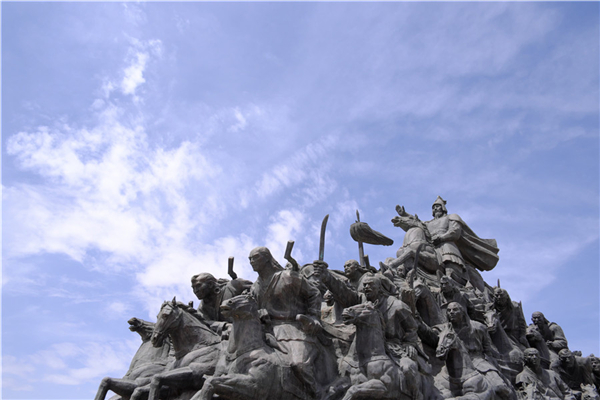A Day in Kangbashi: the Modern Heart of Ordos
Stepping off the train at Ordos railway station, the first thing we noticed was the sky. It was huge, sapphire blue, unblemished. Coming from the hot confines of Beijing's tower-bordered streets, it was a strange relief – especially in these days of COVID-19 confinement – to stand under a sky that comes right down to the horizon in every direction.
The next thing was the statues. A string of huge galloping horsemen, cast in bronze, framed against the distant city skyline. They were a reminder that we had come somewhere new, with a culture and history of its own.
The countryside surrounding the city is largely farmed and flat as a pancake. We zoomed through it on the high-speed train from Hohhot, enjoying, in the grand tradition of all the best train journeys, a couple of chilled brewskis. It was fun to spot various bird species that were spending spring in the area: flocks of waders taking off from a flooded pasture; various hawks patrolling the field margins; eagles soaring overhead.
We were in Ordos on a flying visit at the invite of the local government, with the primary purpose of checking out Kangbashi district – the new urban area built to the north of the Ulan Mulun River – which made international headlines around 15 years ago after pictures of its looming tower blocks and empty streets prompted stories of a "ghost town". Even today, look the place up on a search engine and those are the top results.
But these articles are now out of date, and this is apparent if you spend even the briefest time there.
On our first night, we went down to the lakeside area at the southern end of the huge, oblong park that runs through the core of the district. The area was busy with families, checking out the bombastic musical fountain display, or playing on the various games and rides that pepper the area. Around us, the stylish buildings of the city center, such as the city library and Ordos Museum, were illuminated in a rainbow of neon colors.

The Ordos concert hall, its shape inspired by traditional Mongolian headwear. [Photo by David Mackie/chinadaily.com.cn]
That's not to say Kangbashi doesn't feel quiet, especially after the bustle of Beijing. Its ultra-wide streets may be ideal for social distancing. The district has a population of around 153,000, making it much smaller than Ordos's other, older district of Dongsheng. With a city like this, it appears to be a case of "build it, and they will come." Indeed, from the pinnacle of a monument on the edge of town, hundreds of flags flapping noisily around us, we could see that the city is still growing. The skyline towards the edge of town is peppered with cranes and the skeletons of towering new apartment blocks, a sight which can be seen all over China.
Kangbashi is proud of its education system. Our hosts guided us round an elementary school and a kindergarten and the children showed off their remarkable art and delivered some musical performances. One new elementary school has been built in the graceful shape of a question mark, representing the desire that their pupils never stop learning and asking questions – an admirable philosophy. The local high school has one of the best records in the country of sending students to China's top universities.

Tulips decorate Kangbashi's large central park area. [Photo by David Mackie/chinadaily.com.cn]
Later, we checked out Ordos Museum, a large and stylish structure designed by MAD Architects that borders the open central park. Our guide took us round the exhibits, which tell the story of the human societies who have lived in the area for tens of thousands of years – from early pottery and the skull of a woolly rhinoceros to the ornate gold trinkets of the latter dynasties.
Back outside, the local birdlife once again drew my eye. It being early May, the air was alive with martins. Standing on the steps of the museum, bold-as-brass barn swallows seemed to flit over, around and beneath us. We saw them building their little mud nests on the sides of buildings. On a pond a little further out of town, terns were swooping and diving. I felt glad there is space for such bird species to thrive here.
Mongolian culture is apparent everywhere here, and it does not feel tokenistic to me. Signage is all bilingual, with Mongolian characters as well as Chinese ones. Towering statues of Genghis Khan and his warriors stand in the central square. At the very cool concert hall, its design echoing traditional local headwear, we saw a musical performance with skits delivered in Mongolian. And the rich, dairy-and-mutton-based cuisine is just great. Highlights included the golden pastry pockets called Khuushuur, another dish comprising mutton, buttery potatoes and sour cabbage, and the salty, pinkish milk tea Suutei Tsai that locals drink throughout the day.

Statues of Genghis Khan tower over the city's central square. [Photo by David Mackie/chinadaily.com.cn]
We were also treated to some classic Ordos hospitality, with a Mongolian hotpot and significant quantities of the local baijiu. Generous toasts were given and - even as standing up straight became increasingly difficult - we felt honored to be given such a warm welcome.
With our visit so brief, there were many things we didn't have time for. The mausoleum of Genghis Khan; the A’erzhai grottoes; the nearby desert and grasslands. As we left Inner Mongolia on the train, the flat landscape giving way to the mountains of northern Beijing, I knew that I wanted to return to the area to delve into it more deeply. For any tourists exploring Inner Mongolia, Ordos will make a fascinating stop on your journey.



 Print
Print Mail
Mail





